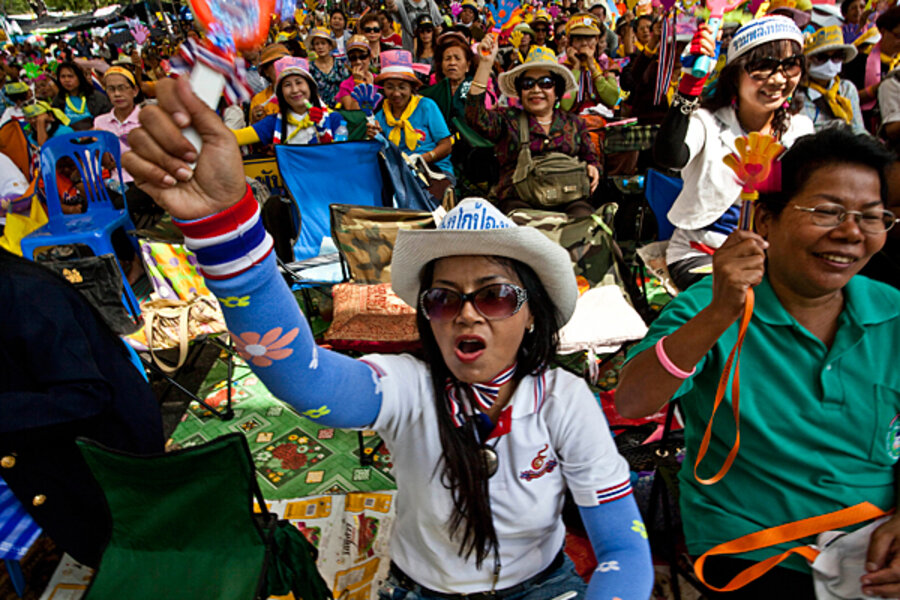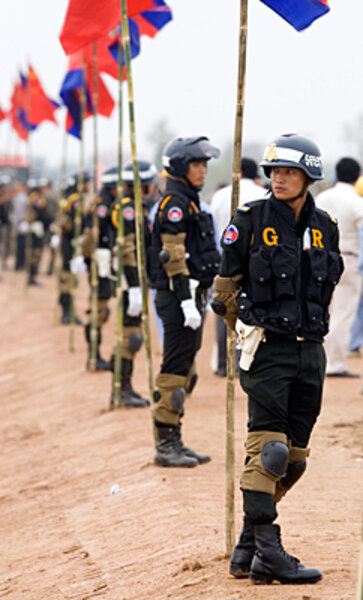UN urges Cambodia-Thailand cease-fire, but will it happen?
Loading...
| Phnom Penh, Cambodia
The UN Security Council has called on Thailand and Cambodia to show “maximum restraint” in a deadly border dispute. But the UN statement will likely do little to resolve tensions between the two countries, which recently clashed violently and have been trading rhetorical barbs while ramping up their military presence along disputed sections of the border.
The conflict centers around Preah Vihear temple, an 11th-century structure near a piece of land claimed by both countries. But the conflict highlights tension along other sections of the border.
A Cambodian court recently convicted two Thai leaders of the “Yellow Shirt” protest movement on espionage charges, and handed out suspended sentences for “illegal entry” to five others who were later released. The group crossed into Cambodian territory in Banteay Meanchey Province while “investigating” demarcation at a contentious section of the border with troops massed on both sides.
Local media here reported Tuesday that families are fleeing coastal villages in Koh Kong province, where it is rumored that the Thai Navy is deploying ships around a disputed, oil-rich marine section of the border. Military and government officials said they had no evidence of a naval buildup.
International mediation?
Cambodia has sought international mediation, asking for a meeting with the Security Council and even calling for the deployment of UN peacekeepers, while Thailand favors bilateral negotiations. The Security Council statement appears to support Thailand’s position, which is likely to frustrate Cambodian authorities.
“The members of the Security Council further urged the parties to establish a permanent cease-fire, and to implement it fully and resolve the situation peacefully and through effective dialogue,” said a statement, released after foreign ministers from both countries addressed the Council on Feb. 14.
IN PICTURES: Preah Vihear temple battle
Thai state media quoted Thai Prime Minister Abhisit Veijajiva saying that the statement “shows that the international community wants both sides to use bilateral talks to end the conflict.”
But Cambodian Foreign Affairs Ministry Spokesman Koy Kuong said such talks have so far failed.
“The reason we made a submission to the Security Council is that the bilateral approach doesn’t work,” he said in an interview. “We have used the bilateral mechanism for three years. The result of it is aggressive clashes.”
Simmering conflict
The conflict has simmered for decades and occasionally exploded into violence, most recently when soldiers exchanged heavy artillery and small arms fire in a series of battles between Feb. 4, and Feb. 7. Thai and Cambodian soldiers and civilians were killed and injured, while the fighting displaced thousands of families on both sides of the border.
The locus of the dispute is a piece of land less than 5 square kilometers at the foot of the temple. The International Court of Justice ruled in 1962 that the temple itself was in Cambodia, but left ownership of the land at the foot of the temple unresolved. Thailand has repeatedly indicated that it accepts the court’s ruling.
But nationalists have accused their government of ceding Thai land to Cambodia, and the temple has become a focal point for anger during times of political instability in Thailand. On Monday, for example, nationalist protesters rallied in Bangkok, calling for Abhisit to step down over his handling of the border dispute.
Many analysts say domestic Thai politics are the root of the border conflict. A nationalist section of the Yellow Shirt movement that helped bring Abhisit to power now wants him gone. For his part, Abhisit has sought to distance himself from the more radical elements of the movement in a bid to gain international support. But those factions have successfully played upon nationalist public sentiment to attack him. Preah Vihear is the key plank in their platform, and it will continue to be as long as Thailand is in political turmoil.
Despite the UN Security Council’s wishes that Thailand and Cambodia settle their differences through dialogue, political turmoil in Thailand shows no signs of abating soon.
Meanwhile, both countries have massed troops and military equipment along the border. With Thailand and Cambodia facing off on military and diplomatic fronts, the dispute is more likely to continue as it has for decades, periodically claiming lives on either side of the border.






